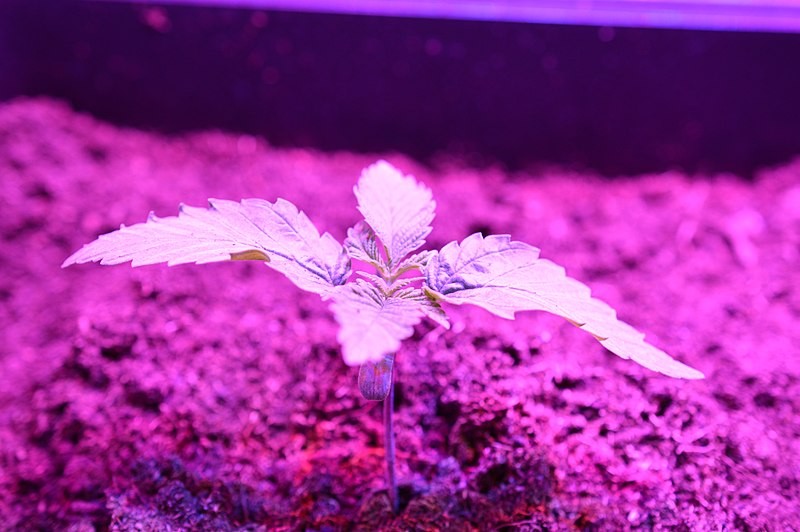01/2018 | LED grow lights for medical cannabis
Part II – Pros and cons of the technology
LED grow lights for medical cannabis is a subject both interesting and complicated. This article is in three parts: In part I, I talked about background and properties of the market for agricultural LED grow lights. In part III, I will talk about how to select the most suitable product. * I stated my full disclosure in the beginning of part I. Welcome to part II of this article. The part that talks about all the pros and cons of LED lights for growing medical cannabis.LED grow lights for medical cannabis have both advantages and disadvantages. I will address some of them here so we can start to be on the same page. I'll start with the cons: disadvantages / problems / challenges facing us. First, price. We can't avoid the fact that purchasing LED lighting which is effective for growing cannabis is more expensive than the well-known HPS or MH lighting and this is the biggest disadvantage of this technology. When purchasing, you will pay more without a doubt. Furthermore, in 2017/18 if you haven't paid significantly more, it would be strange, and I would check the reliability of the source as well as the effectiveness of the light fixture. However we look at it, this is a disadvantage of the technology. The variety of supply combined with lack of professional knowledge creates confusion and uncertainty as to which is the best solution. If you wish to buy a lighting fixture from previous technologies then the answers concerning manufacturers, types and capabilities are available, and we know which fixture gives each solution we require. In the LED lighting field there are so many manufactures that market so many different products that it is hard to decide which the best product for each situation is. Because of the "trendiness" of this field, many manufacturers and suppliers offer varied solutions without the ability and knowhow to back it up. Suddenly, everyone is manufacturing LED grow lights for cannabis, but few have the true capability to do this correctly. This leaves us in a quandary as to how to select a reliable product that works. The professionalism of the grower in a cannabis growing facility using LED lighting will be a key component in the success of the crop. This technology has advantages which, in the wrong hands, turn to disadvantages. This technology opens us to myriad uses of spectrum and lighting intensity, which is wonderful. However, if, in the past, we just turned the lights on and off, now the grower who wishes to use his LED lighting correctly needs to define the spectrum he needs at each stage and the optimum intensity for his crop. This is a professional challenge such that only those who invested, experimented and studied will be able to harness this technology for their benefit. * At this stage you should be thinking "how do I know what to choose?" Relax, we'll get to that in the third part of the article. * |
Now, the fun part. What are the pros: advantages of LED lighting?When we want to grow medical cannabis of consistently high quality, economically viable and suits the needs of our patients? In my view the greatest advantage of LED agricultural lighting is the option to alter the spectrum of the lights during the growth cycle, according to each stage in each crop. Mother plants will need a different spectrum and intensities from flowering plants and seedlings need different lighting from vegetating plants. Today there are LED light fixtures available where the spectrum and intensity can be altered during growth. The benefit of this is, that we can work with light protocols to suit the growth stages throughout the growing facility at any particular time. There is no need to move plants or change light bulbs and this makes it easier on the plants which don't need to adapt to different growing areas within the facility between seedling and picking stages. We still can't evaluate how groundbreaking this is, simply because it's so new. |  |
In my opinion this is a true GAMECHANGER. This will allow us to optimize what we grow and will allow for better quality crops.Another advantage in controlling the light spectrum is adaptation of lighting protocols for different strains. Implementing precise conditions can affect the final composition of cannabinoids in the buds. This is highly significant when manufacturing medicine as different combinations treat different symptoms in patients. * For beginners, I would still recommend choosing a light fixture with a static spectrum which will make success more likely. Even though the options are greater with dynamic spectrums, this needs a high level of professionalism * The natural link between LED technology and control systems opens a whole world of possibilities. We can install ambient PAR sensors to lighting fixtures and define required DLI throughout the greenhouse. On cloudy days, the sensors will automatically increase light levels with the LEDs, which allows optimum lighting, with minimal energy consumption, throughout the growth cycle. The controller also allows the establishment of lighting protocol throughout the growth cycle and automatically encompassing changes made by the grower. Of course, this also helps with operational control, recognizing and minimizing faults, allowing long term optimization to the growth protocol. With LED technology, heat emission from the lighting fixtures is minimal. This allows installation in closed spaces with smaller HVAC systems, and we can decrease the physical distance between light source and plants without any damage to the plants. This also decreases the effect of lighting on the climate in the structure. It can lessen the cost of air treatment systems and lower energy costs. Lighting can serve as a tool for research. At the same time parallel to the development of LED lighting we see the advances in horticulture and indoor agriculture, as well as advanced agriculture in general. LED lighting fixtures with flexible spectrums and dimming capabilities will become valuable tools in the research facilities working on developing new methods and protocols for growing crops. The fact that LED lighting turns on at full power within less than a second is an advantage when planning exactly the number of hours required when lighting cannabis or other crops. There is no 15 minute heating time and, if the fixture had been turned off, there is no need to wait half an hour of cooling to switch it back on. Photometry of LED light fixtures is a dream for any professional planner/designer/manufacturer of light fixtures. When I write photometry, I am talking about designing the beam that the light fixture produces. I am not a great physicist, however I know the principle that the smaller the light source, the easier it is to control the shape of the beam. This is important because, when using correct photometry we can use direct light to illuminate only the growing area, which means savings in resources and optimum use of our fixtures to grow our marijuana. LED is a small diode a few square millimeters. Compare that to the size a standard HPS or MH light bulb or any other bulb you know and you'll see the huge advantage of LED in photometry.The life span of an LED fixture of reasonable quality is 50,000 hours. This doesn't mean that it will stop working after that time. Life span of LED light fixtures is usually measured up to the time when the lighting intensity drops to 70% of what it was on the first day. In comparison to other products available in the market, this is 2-4 times the life span. This translates immediately to decreased operational costs in maintenance, purchasing replacements, manpower, etc. Energy efficiency of LED lighting is usually the first advantage talked about. I imagine, that today many people know about this and I wanted to change thing up so left it for last. An LED grow light for medical cannabis will save 40%-80% in electricity as compared to HPS or MH technologies in use today. This is a saving that translates to a lot of money on the electricity bill. When setting up a new facility this saves money by using lighter infrastructure, with lower electric current requirements and a smaller backup generator. * Man, I love writing about benefits * _____________________________________________ In this part of the article I covered the main pros and cons in this technology. There are many more nuances and subjects that we can talk about and you are welcome to contact me to discuss further. After all this how do we know what to buy? In part III, the final part of this article, I'll talk about exactly that. |
